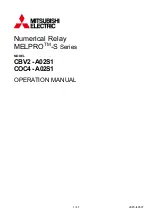
IPC1 USER MANUAL ISSUE 9
-7-
The instantaneous current in each of the three
phases can be displayed on the RDM (Level 5,
Position 1). The three phase currents are displayed,
as a % of the overload set current. The average
current value is expressed in Amps and is displayed
at Level 5 and the Status Page (Level 0, Position 0).
Following a trip condition the following conditions
must be met to achieve a reset:
a)
The IPC reset input must be closed
b)
The trip accumulator must be less than 80%
4.2 Overcurrent Characteristic
If the selected overcurrent type is “vInv”, then a
very inverse overcurrent characteristic set of curves
are available for selection. (See “vInv” Curves,
Drawing IPB-B-004, Page 22).
The three phase currents are compared and the
highest current is used to calculate the trip time. If
the current exceeds the selected full load current an
“overcurrent trip accumulator” increases at a rate
determined by the current and the selected curve.
This can be displayed on the RDM (Level 5,
Position 2). When the current falls below the
selected full load current the trip accumulator
reduces towards zero rapidly, however, if the
overcurrent condition persists so that the trip
accumulator reaches 100% then a trip occurs. If
viewed during start up the trip accumulator can
help determine if overcurrent settings are correct.
If a trip occurs the “OC” LED on the Remote
Display Module is illuminated and the open
collector output on the relay is switched on to
provide remote monitoring if required.
To reset the relay following an overcurrent trip,
operate the reset button.
4.3 Motor Overload Characteristic
The overcurrent type “m-OL” is used when a motor
overload characteristic is required (See “m-OL”
Curves, Drawing IPB-B-005, Page 23). This
characteristic uses a thermal model of the motor to
determine the tripping characteristic. The motor
overload curves are shown for both cold and hot
conditions. The hot curve corresponds to the trip
time after the motor has been running at the
selected full load current indefinitely.
The motor manufacturer’s data should be consulted
to select the time multiplier appropriate for the
motor being protected. Typically, the capacity of a
cold motor is given at six times its rated current.
The IPC trip curves can be used to select the time
multiplier, which best suits the motors overload
capacity.
Thermal Model
Thermal modeling is based on a thermal time
constant of 30 minutes (time multiplier setting of
1.0 times). The time multiplier can reduce this
value to a minimum thermal time constant of 1.5
minutes (time multiplier setting of 0.05 times).
The three measured phase currents are squared and
added together to provide the heating input into the
thermal model.
While the main contactor is closed, the cooling
output from the thermal model is calculated to
achieve the necessary time constants.
When the main contactor is open a “Cooling
Multiplier” is used to modify the basic time
constant. This can be used to account for the
reduced cooling capacity while the motor is not
running (when applicable). This multiplier is
selectable at 0.2, 0.3, 0.4, 0.5, 0.8, 1.0, 2, 5, 10, 20,
and 50 times.
A selection of 1.0 times sets the motor off cooling
rate equal to motor running cooling rate. This
selection is appropriate where cooling is maintained
even when the motor is stopped, eg water cooled
motors.
When 0.2 times is selected the motor off cooling
rate is reduced to 20% of the motor running cooling
rate.
A selection of 50 times effectively disables the
thermal memory. With this selection, as soon as
the main contactor opens, the thermal model resets
quickly so that a cold restart is achieved.
Caution: Repeated restart attempts in this
condition may damage the motor.
Typical fan cooled motor protection is based on a
setting of 0.4, however, for the best protection
consult your motor manufacturer.
The thermal model continues to simulate the motors
thermal behaviour even if the power is removed
from the relay. When power is restored the thermal
memory would be at the same level had there been
no loss of power.
The “OC Trip” Accumulator shows the state of the
thermal model: 0% = Cold, 100% = Trip.
When a trip occurs the IPC Relay cannot be reset,
by operation of the reset button, until the
accumulator is less than 80%. In order that an
emergency restart on a hot motor can be achieved a
reset of the thermal memory is possible by selecting
Level 5, Position 3 on the Remote Display Module.
The display shows:
Содержание IPC1
Страница 24: ......
Страница 25: ...AMPCONTROL PTY LTD 21 ...
Страница 26: ...AMPCONTROL PTY LTD 22 ...
Страница 27: ... 23 ...
Страница 33: ...120 0 mm 140 0 mm 8 0 mm RL4 110Vcom Vcma Vcmb Vcmc Earth CCMC 415 Va Vb Vc AMPCONTROL PTY LTD 29 ...
Страница 36: ... 32 AMPCONTROL CSM PTY LTD ...
Страница 41: ......
Страница 42: ......
Страница 43: ......
Страница 44: ......
Страница 45: ......
Страница 46: ......
Страница 47: ......
Страница 48: ......
Страница 49: ......
Страница 50: ......
Страница 51: ......
Страница 52: ......
Страница 53: ......












































